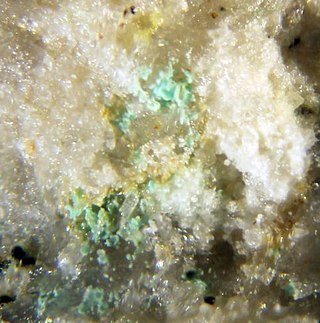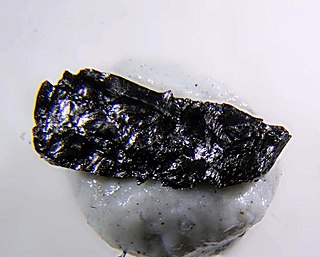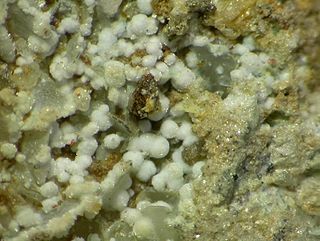Related Research Articles

The name apophyllite refers to a specific group of phyllosilicates, a class of minerals. Originally, the group name referred to a specific mineral, but was redefined in 1978 to stand for a class of minerals of similar chemical makeup that comprise a solid solution series, and includes the members fluorapophyllite-(K), fluorapophyllite-(Na), hydroxyapophyllite-(K). The name apophyllite is derived from the Greek ἀποφυλλίζω apophylliso, meaning "it flakes off", a reference to this class's tendency to flake apart when heated, due to water loss. Exfoliation of apophyllite is also possible by treating it with acids or simply by rubbing it. These minerals are typically found as secondary minerals in vesicles in basalt or other volcanic rocks. A recent change (2008) in the nomenclature system used for this group was approved by the International Mineralogical Association, removing the prefixes from the species names and using suffixes to designate the species. A subsequent nomenclature change approved by the International Mineralogical Association in 2013 renamed the minerals to include both suffixes and prefixes, as shown above.

Cesbronite is a copper-tellurium oxysalt mineral with the chemical formula Cu3Te6+O4(OH)4 (IMA 17-C). It is colored green and its crystals are orthorhombic dipyramidal. Cesbronite is rated 3 on the Mohs Scale. It is named after Fabien Cesbron (born 1938), a French mineralogist.

Fluor-buergerite, originally named buergerite, is a mineral species belonging to the tourmaline group. It was first described for an occurrence in rhyolitic cavities near Mexquitic, San Luis Potosi, Mexico. It was approved as a mineral in 1966 by the IMA and named in honor of Martin J. Buerger (1903–1986), professor of mineralogy at the Massachusetts Institute of Technology. It has also been reported from Minas Gerais, Brazil, and the Central Bohemia Region of the Czech Republic.
Brownleeite is a silicide mineral with chemical formula MnSi. It was discovered by researchers of the Johnson Space Center in Houston while analyzing the Pi Puppid particle shower of the comet 26P/Grigg-Skjellerup. The only other known natural manganese silicide is mavlyanovite, Mn5Si3.
Sacrofanite is a rare silicate mineral that has the general formula of (Na,Ca)9(Si,Al)12O24(SO4,CO3,OH,Cl)4·n(H2O). It was approved as a mineral by the International Mineralogical Association in 1980. Its name comes from the Sacrofano Caldera in the Monti Sabatini from which it was discovered in Latium, Italy.
Wassonite is an extremely rare titanium sulfide mineral with chemical formula TiS. Its discovery was announced in a 2011 NASA press release as a single small grain within an enstatite chondrite meteorite called "Yamato 691", which was found during a 1969 Japanese expedition to Antarctica. This grain represents the first observation in nature of the synthetic compound titanium(II) sulfide.
Georgerobinsonite, named for George Willard Robinson, is a lead chromate mineral with formula Pb4(CrO4)2(OH)2FCl. It exhibits very small, transparent crystals with a bright orange-red color. It was obtained from the Mammoth–St. Anthony Mine in Arizona in the 1940s and identified in 2009.

Strashimirite (IMA symbol: Ssh) is a rare monoclinic mineral containing arsenic, copper, hydrogen, and oxygen. It has the chemical formula Cu8(AsO4)4(OH)4·5(H2O).

Achávalite a selenide mineral that is a member of the nickeline group. It has only been found in a single Argentinian mine system, being first discovered in 1939 in a selenide deposit. The type locality is Cacheuta mine, Sierra de Cacheuta, Mendoza, Argentina.

Brianyoungite is a secondary zinc carbonate mineral. The Commission on New Minerals, Nomenclature and Classification (CNMNC) of the International Mineralogical Association (IMA) classifies it as a carbonate with the formula Zn3(CO3)(OH)4, but sulfate groups SO4 also occupy the carbonate CO3 positions, in the ratio of about one sulfate to three carbonates, so other sources give the formula as Zn3(CO3,SO4)(OH)4, and Gaines et al. classify the mineral as a compound carbonate. It is similar in appearance to hydrozincite, another zinc carbonate. It was discovered in 1991 and designated IMA1991-053. In 1993 it was named "brianyoungite" after Brian Young (born 1947), a field geologist with the British Geological Survey, who provided the first specimens.
Kuratite, named for Dr. Gero Kurat (1938–2009), meteorite researcher and Curator of the Meteorite Collection at the Vienna Natural History Museum, was first recognized as a new mineral by the Commission on New Minerals, Nomenclature and Classification in 2014 from a small meteorite sample.
Ilyukhinite is a very rare mineral of the eudialyte group, with formula (H3O,Na)14Ca6Mn2Zr3Si26O72(OH)2·3H2O. The formula given is simplified and does not show the presence of cyclic silicate groups. Ilyukhinite is the second group representative with species-defining hydronium ion after aqualite.
Fengchengite is a rare mineral of the eudialyte group with the formula Na12[ ]3(Ca,Sr)6Fe33+Zr3Si(Si25O73)(H2O,OH)3(OH,Cl)2. The formula is simplified as it does not show the presence of cyclic silicate groups. When compared to other minerals of the group, fengchengite characterizes in the presence of ferric iron and essential, site-dominating vacancies. The mineral was discovered in the Saima complex near Fengcheng city in China - hence its name.
Fluorcarmoite-(BaNa) is a rare phosphate mineral, belonging to arrojadite group, with the formula Ba[]Na2Na2[]CaMg13Al(PO4)11(PO3OH)F2. It is a barium-rich member of the group, as is arrojadite-(BaNa), arrojadite-(BaFe), fluorarrojadite-(BaFe) and an unapproved species ferri-arrojadite-(BaNa). The "-(BaNa)" suffix informs about the dominance of the particular elements (here barium and sodium) at the corresponding structural sites.
Manganiceladonite is a rare silicate mineral with the formula KMgMn3+Si4O10(OH)2. It is one of many minerals discovered in the Cerchiara mine, La Spezia, Liguria, Italy.
Lislkirchnerite is a rare nitrate mineral with the formula Pb6Al(OH)8Cl2(NO3)5•2H2O. It was discovered in Nueva Esperanza No. 1 mine within the Capillitas deposit, Catamarca, Argentina.
Kalgoorlieite (IMA2015-119) is a mineral from Kalgoorlie, Western Australia.
Parisite-(La) is mineral discovered by Daniel Atencio of the University of São Paulo and colleagues in the Mula claim, Bahia, Brazil. Parisite-(La) is the lanthanum analog of parisite-(Ce), which has the same structure, but with cerium substituted for lanthanum. Parisite-(La) is chemically similar to synchysite-(La).
Achalaite ((Fe2+, Mn)(Ti, Fe3+, Ta)(Nb, Ta)2O8) is a black mineral of the wodginite group, first discovered in 2013.
References
- ↑ Warr, L.N. (2021). "IMA–CNMNC approved mineral symbols". Mineralogical Magazine. 85 (3): 291–320. Bibcode:2021MinM...85..291W. doi: 10.1180/mgm.2021.43 . S2CID 235729616.
- ↑ Hålenius U., Hatert F., Pasero M. et al. IMA Commission on New Minerals, Nomenclature and Classification (CNMNC) Newsletter 33. New minerals and nomenclature modifications approved in 2016 // Mineralogical Magazine — Cambridge University Press, 2016. — Vol. 80, Iss. 6. — P. 1135–1144
- ↑ Roymillerite. Mineral information.
- ↑ Mineralienatlas Lexikon — Kapitel / Geologie. Roymillerit